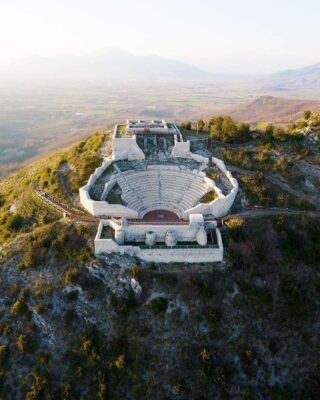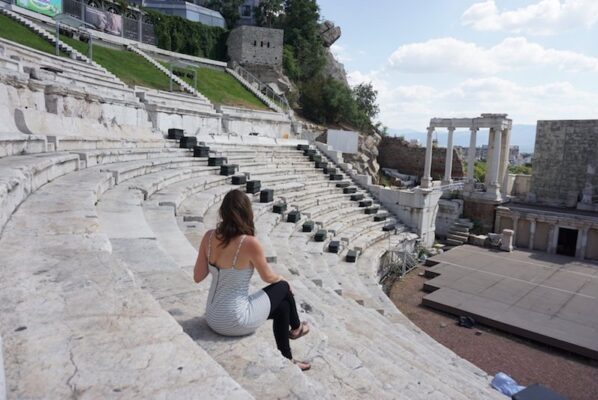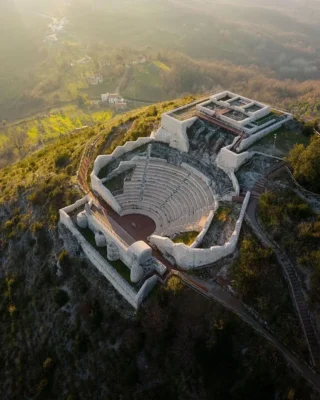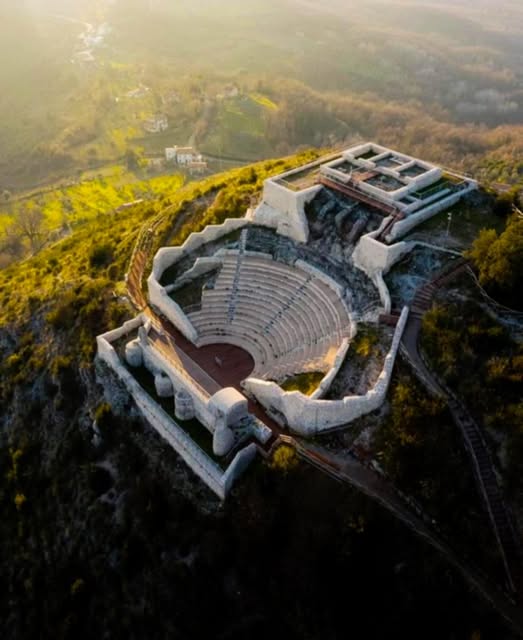Accidentally discovered by Nicolino Lombardi while flying in his ultralight helicopter, the Temple-Theater of Monte San Nicola in the Upper Casertano region of Italy offers a glimpse into a rich historical narrative from the late Roman Republican period. This extraordinary archaeological site, concealed for centuries beneath thick vegetation, has sparked debates about its origins, including whether it was built by Roman architects or local Italic tribes such as the Samnites. Let’s explore many ancient Egyptian civilizations with archeology.dulichvn.net

The Discovery of the Temple-Theater
An Accidental Discovery
The Temple-Theater of Monte San Nicola remained hidden for centuries until it was inadvertently discovered by Nicolino Lombardi in 2013. His aerial exploration revealed the outline of the structure, which had been obscured by the dense forests of the Upper Casertano region.
Location and Elevation
The temple-theater complex is located at an elevation of 410 meters in the scenic Sannio region of Italy. The area is known for its picturesque landscapes, making the discovery even more intriguing. The complex’s strategic location allows for a commanding view of the surrounding land, which may have held military significance.
A Rare Find in Archaeology
This site represents a rare find in archaeological exploration, offering insight into a time period marked by Roman expansion and the influence of indigenous Italic tribes. Its hidden nature means that it has remained largely untouched, preserving valuable historical details that contribute to our understanding of ancient Italy.

The Historical Significance Temple-Theater of Monte San Nicola
The Late Roman Republican Period
The Temple-Theater of Monte San Nicola dates back to the late Roman Republican period, around the 2nd to 1st century BC. This was a time when Rome was asserting its dominance, particularly after victories over rivals like Carthage and local Italian tribes.
Roman vs. Samnite Influence
There is ongoing debate among historians and archaeologists about whether the structure was built by Roman architects or by indigenous Italic tribes, such as the Samnites, who once inhabited the area. The architecture and design of the complex may offer clues as to who was responsible for its construction.
Symbol of Roman Power
If the dating of the site is accurate, the construction of the temple-theater coincided with Rome’s victories in the Punic Wars and its expansion into the Italian peninsula. The strategic positioning of the structure overlooking key northern routes suggests that it may have been a symbol of Roman influence and power over the region.

The Strategic Importance of the Temple-Theater
Overlooking Key Northern Routes
Situated at a high elevation, the Temple-Theater of Monte San Nicola provided an advantageous vantage point over critical northern routes in Italy. This strategic location would have been important for monitoring trade, military movement, and potential threats in the area.
Tombs and Decline by the 2nd Century AD
Nearby tombs indicate that the complex fell out of use by the 2nd century AD, signaling a shift in the area’s significance. This suggests that the site may have been abandoned or repurposed as Rome’s power in the region grew stronger.
The Samnite Theater at Pietrabbondante Comparison
Much like the Samnite theater at Pietrabbondante, the Temple-Theater of Monte San Nicola represents the intersection of Roman and indigenous Italic cultures. The similarities between the two sites highlight the transition from local autonomy to Roman control over the Italian landscape, shaped by ongoing rivalries and Roman aspirations for dominance.

The Ongoing Debate: Roman vs. Samnite Construction
Architectural Evidence
The architectural features of the Temple-Theater of Monte San Nicola are key to understanding its origins. Some scholars argue that Roman influence is evident in the design, while others suggest that it may be the work of the Samnites, who were known for their distinct architectural style.
Cultural Significance
The debate over who built the temple-theater reflects the broader cultural dynamics of the time. Roman control over Italy was not absolute, and the persistence of local tribes like the Samnites played a significant role in shaping the region’s identity.
Future Research Opportunities
Ongoing archaeological research at the site may provide more definitive answers about its construction and purpose. As more discoveries are made, it is likely that we will gain deeper insight into the interactions between Rome and the indigenous Italic tribes during this period.
See more: Exploring the Enigmatic Abandoned Town of Craco, Italy
Conclusion: A Monument to Roman and Italic Rivalries
The Temple-Theater of Monte San Nicola stands as a powerful testament to the complex history of Italy during the late Roman Republic. Whether built by Roman architects or indigenous Samnite tribes, it symbolizes the region’s rich and tumultuous past, where cultures collided and the forces of Rome expanded. Situated in a strategic location, the temple-theater complex offers a unique glimpse into the ancient world, revealing the intertwined legacies of Roman power and local traditions.


CÁC TIN KHÁC
Mark Twain & Olivia Langdon: A 36-Year Love Story Filled with Laughter and Devotion
The Tollund Man: A 2,400-Year-Old Mystery Preserved in a Danish Bog
Skara Brae: Scotland’s Hidden Neolithic Village
Porta Nigra: The Hidden Depths of Trier’s Iconic Roman Gate